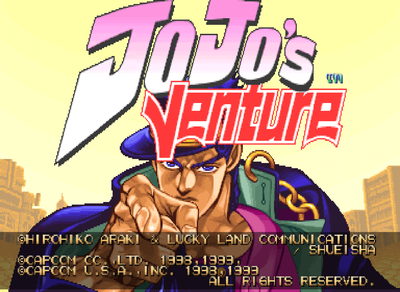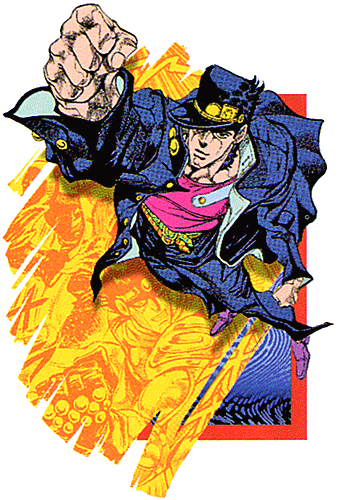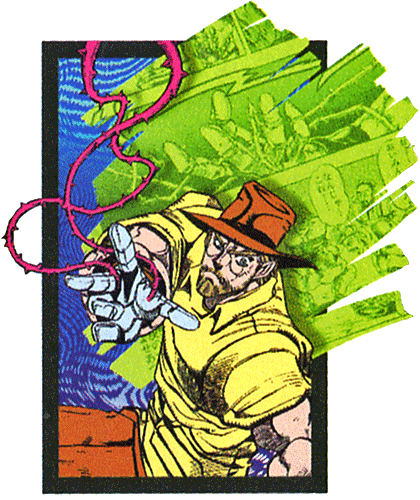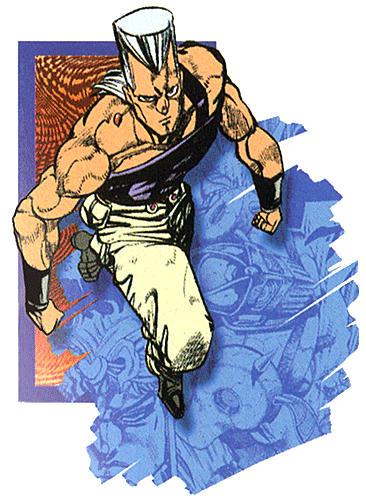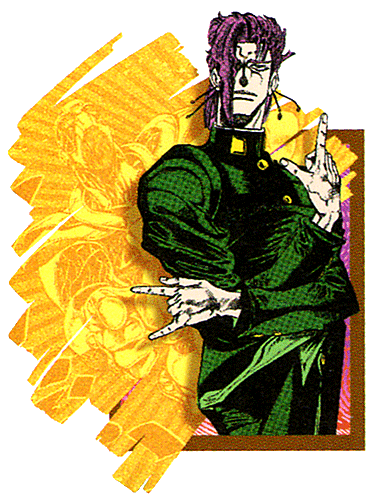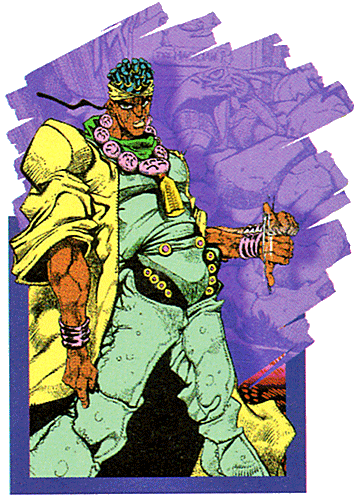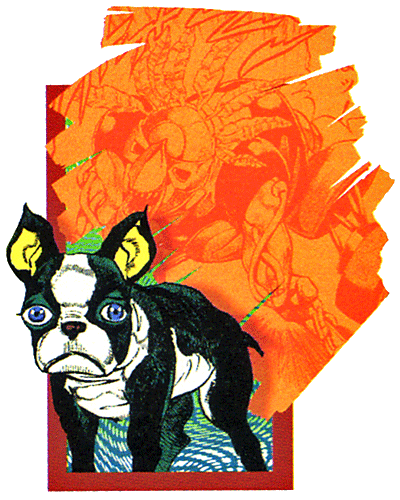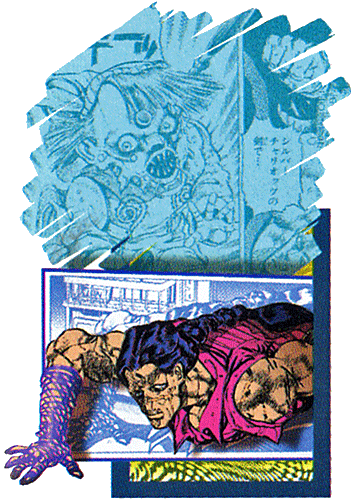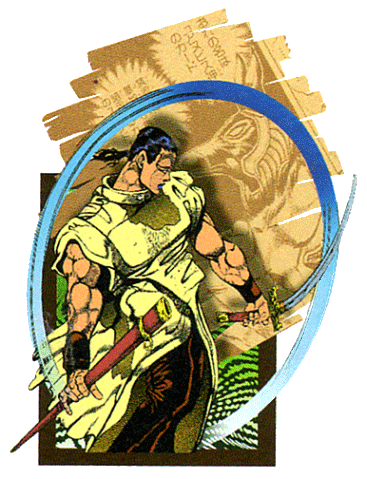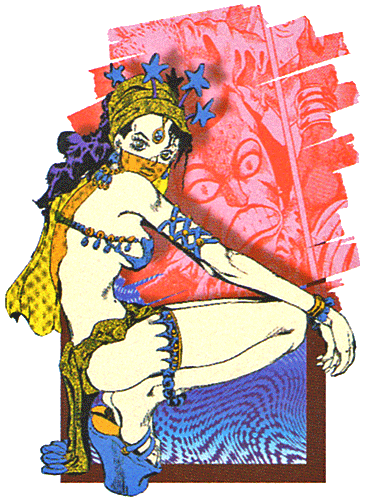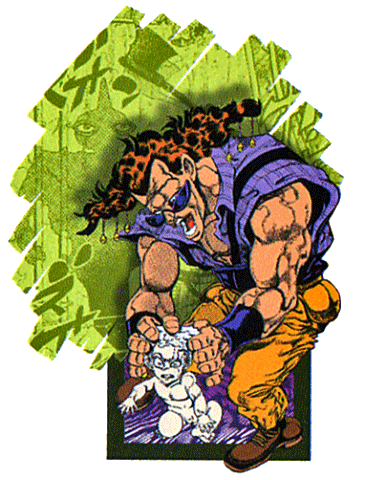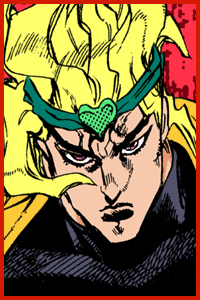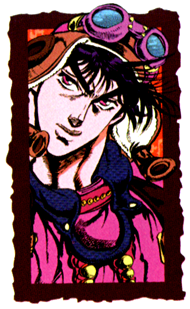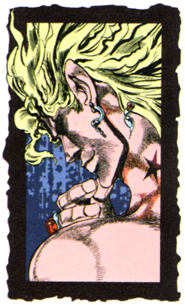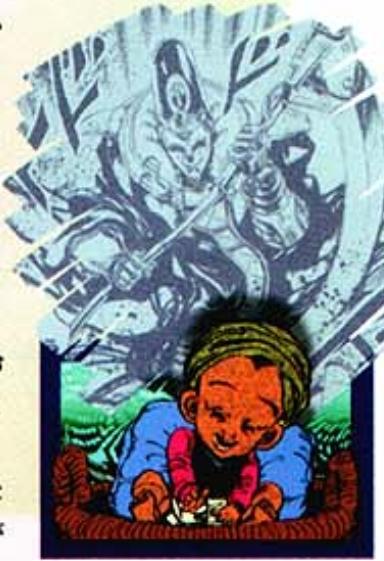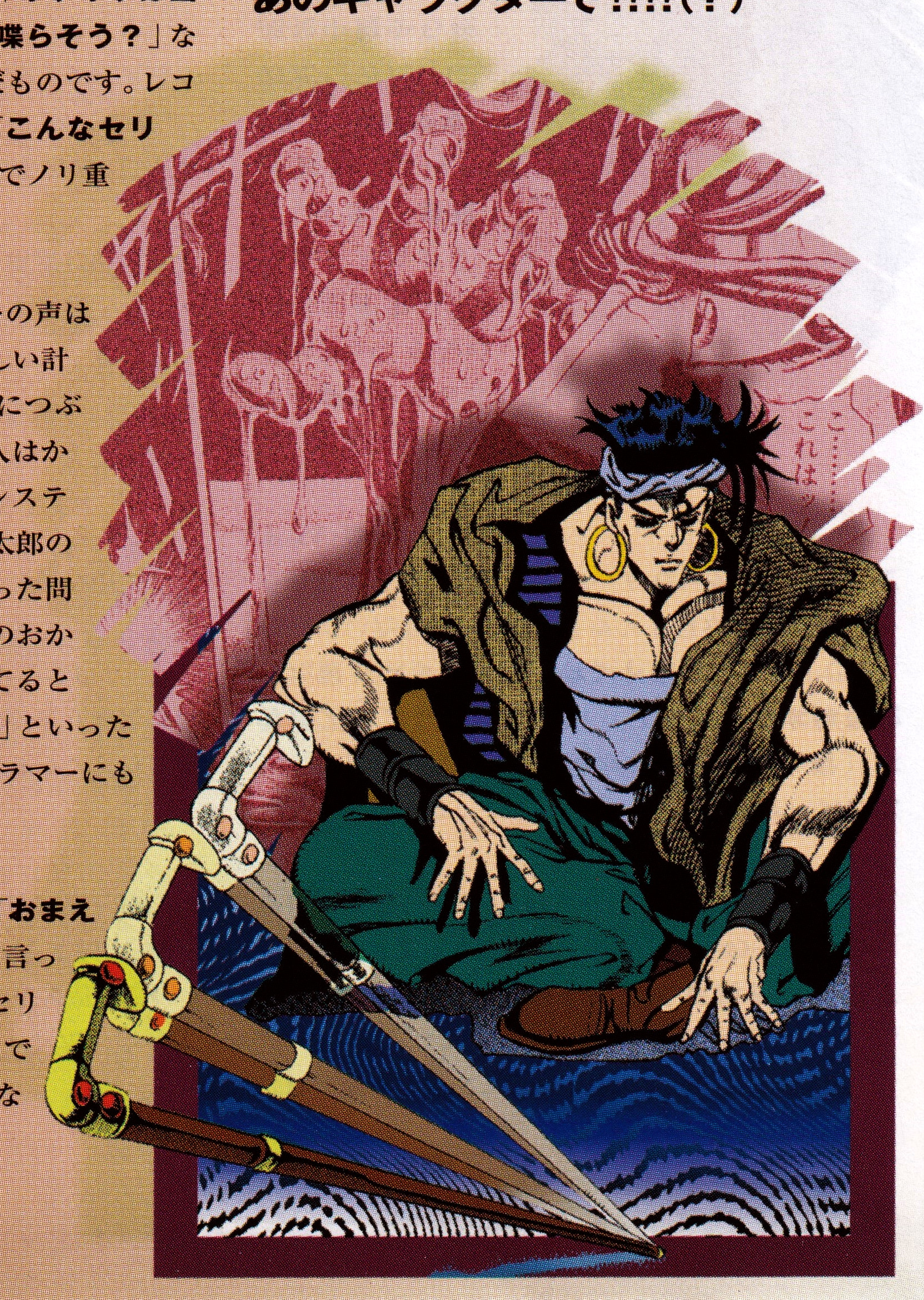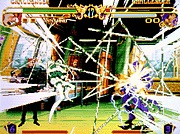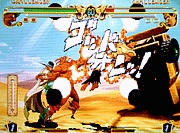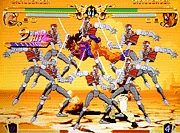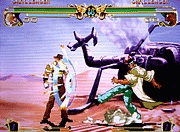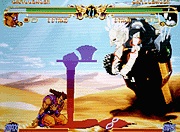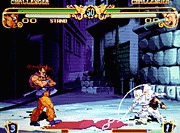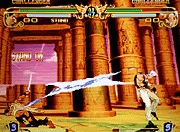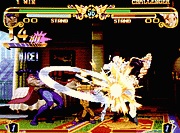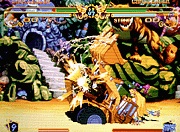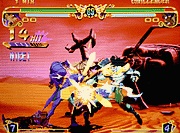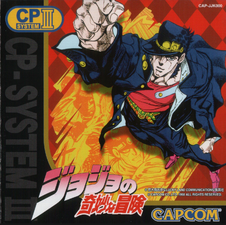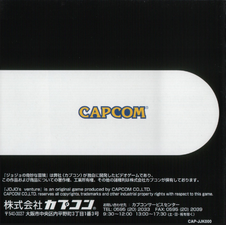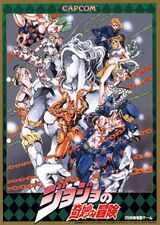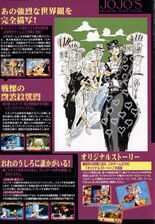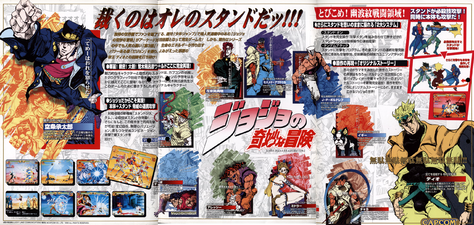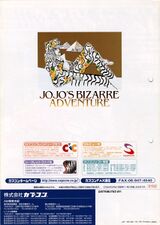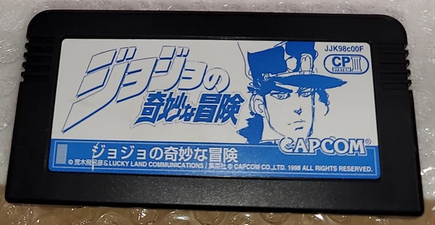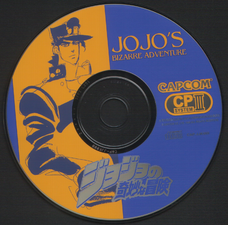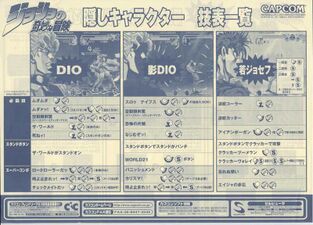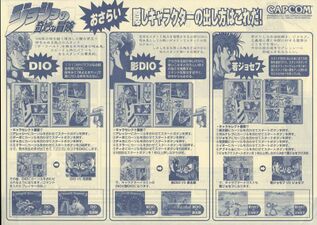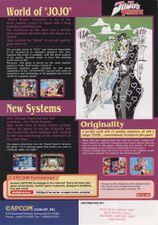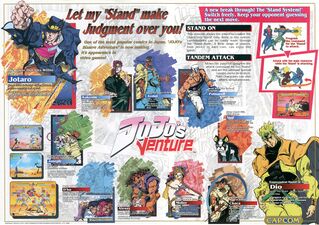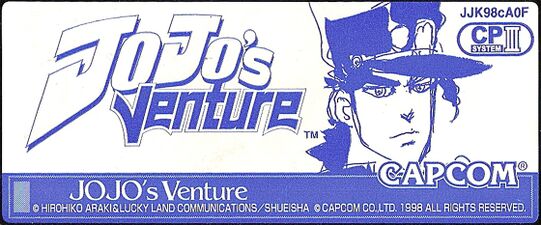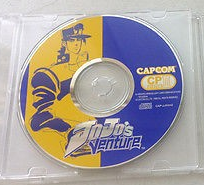JoJo's Bizarre Adventure (arcade)

|
Note: This is a user's personal page attached to their profile! This is not an actual article, may not be related to JoJo or Araki, and is not associated with the wiki. As such, it may not adhere to the policies. |
JoJo's Bizarre Adventure (ジョジョの奇妙な冒険, JoJo no Kimyō na Bōken) is a 2D fighting game developed by Capcom based on the third part of the JoJo's Bizarre Adventure series, Stardust Crusaders. It was originally released in arcades in Japan on December 2, 1998 for the CPS-3 arcade system. It was also localised outside of Japan as JOJO's Venture for arcades in North America in 1998.[4]
An sequel titled JoJo's Bizarre Adventure: Heritage for the Future was later released on September 13, 1999. This version featured updated gameplay and additional playable characters.
Summary
The game were developed by the same team responsible for the Street Fighter III series. The game combines Capcom's trademark anime-inspired graphics, as seen in the Darkstalkers series, with the colorful characters and events of Hirohiko Araki's creation, resulting in a highly stylized and detailed visual style. It also features many of the gameplay mechanics seen on previous Capcom fighting games, such as the use of power gauges for super moves, as well as a brand new Stand Mode, where a character's Stand can be summoned or dismissed at will by the player, resulting in variations on the character's move list and abilities.
Hirohiko Araki served as a consultant for the game and created exclusive pieces of artwork for its promotion and packaging; most notably, he developed from scratch a new character design for Midler, since Capcom was interested in using her in the game and she had been only vaguely shown in the original manga. Araki patterned most of Midler's revised design from Yukako Yamagishi from Diamond is Unbreakable, having similar body builds.
The game prominently features illustrations straight from the manga, some with unique touches just for the game. Most notable in the game is the face-shot of a defeated enemy if finished off with a super combo move, whose animation also reflects the kind of damage received; the portrait would be riddled with bullet holes, bisected or bloodied, depending on the finishing move.
Later revisions of the games include shoutouts to other parts of the series.
This game and its revisions were among the first pieces of JoJo-related media released in North America, exposing the series and its characters to many western players and audiences for the first time.
Gameplay
The basic gameplay mechanics are those of a standard fighting game: one-on-one battles consisting of two or three time-limited rounds, in which the goal is to deplete the adversary's health bar using both regular attacks as well as character-specific special and super moves, which require the input of button combinations and/or spending accumulated energy, outputted in a power gauge which fills with every time damage is dealt or taken.
The game uses a simplified 4-button control scheme, consisting of three attacks (light, medium, and heavy) and a Stand button, which switches the character's Stand On and Off (see Stand Mode below). Push blocking is possible to force attacking foes a set distance whilst blocking an attack, as well as inputting all 3 basic attack buttons for a forward-yet-somewhat-laggy invulnerable dodge.
Stand Mode
Fighting with the Stand Mode "On" enhances both the character's offensive and defensive abilities; these improvements heavily depend on the character and Stand, but some common ones are for example double jumping, absorbing residual damage when blocking special attacks, powered-up special moves, etc.
Stands themselves tend to act as akin to the source material, physical extensions of their users, where damage inflicted upon them carries over to the User via mirroring the connecting attack's hit effects. They also act very akin to avatar/puppet-based characters in other fighting games, being able to act as disjointed-attacking entities separate of their user/wielder, allowing for plenty of offensive gimmicks.
Most of the game's specific mechanics derive from the introduced Stand Mode. For example, the aforementioned aspects of Stands and their users sharing their taken damage upon one or the other is a crucial strategic element, since many of the special moves and attacks send the Stand away from the User, adding the difficulty of protecting both of them at the same time; if a character is damaged while their Stand is far away, the damage received is doubled. On top of the usual health bar and power gauge, there is a third meter, the Stand Gauge, which decreases when the Stand is damaged and refills when the Stand Mode is switched off; if this gauge is depleted, a Stand Crash takes effect, and the character is paralyzed and wide open to any attack for an instant.
Other features of the Stand Mode include summoning the Stand with an instant attack, the possibility of "programming" attack patterns on the fly and unleashing them at will, "releasing" the Stand and controlling it directly, and so forth.
Some characters lack an "active" Stand/Stand Mode, though; some of these "passive" Stand Users introduce even more complex and specific mechanics into the game, such as Hol Horse's Emperor, a gun Stand, or Mariah's magnetic Stand Bastet. Characters like Chaka and Joseph however, have their stands wielded as "weapon" Stands. Only changing their base moveset without any disjointed entity beside them.
Most passive users only summon Stands for a brief attack/animation before they vanish unless called again, but the Stand can still be attacked directly with the same kind of damage mechanics. Furthermore, passive Stand Users may also have their own animations recovery/function independently of their Stand's animations moreso than active Users.
The functions of each Stand create strong differences between the characters, and force often radically different offensive approaches for each one; this "character-dependent gameplay" style would be later present in posterior fighting games, such as the latter entries of the Guilty Gear series, which, interestingly enough, also contains Rock and pop music references.
For the most part regardless of a Stand being either an active type or passive type, a victim being "sandwiched" between a Stand and their User has their blocking orientation based on their position towards the User, and not the Stand. Though the approach varies for most standard active and passive Stand Users, both mainly focus on attacking/acting in a disjointed manner different from one another, creating all sorts of offensive mixups.
Another feature is the Tandem mode only for active and weapon Stand Users. Upon executing the command with 1 stock of super meter to expend, it functions akin to a super, only during the period of the rather extensive startup flash, inputs can be rapidly done within the set interval to allow the Stand to perform the inputted button commands on their own while the User is free to do as they please, though controlling the Stand directly with a special-move-command of any sort will cancel the Stand's input-predetermined onslaught early. Weapon Stand Users on the other hand, only access a "custom combo" mode where nearly all of their moves are freely-self-cancel-able into one another for the duration.
PlayStation
A PlayStation version of the game was released on October 14, 1999. It based on the first game, but including the characters introduced in the second game, Heritage for the Future. Due to hardware limiations, many of the graphics used in-game were reduced, including a palette reduction on the sprites used for Stands. The PlayStation version also features a new "Super Story Mode", which goes through the events of Stardust Crusaders.
Dreamcast
The first and second game were ported as a 2-in-1 collection on the Sega Dreamcast.
Characters
Bosses
Regional Differences
The title of the first game is JoJo's Bizarre Adventure in Japan. However, for the American version, this was changed to JOJO's Venture. This name also change was kept in the arcade and Dreamcast port of the game.
Censorship
In the American version of the game, the blade of Chaka's sword is changed to a wooden brown color. This is changed in both his in-game sprites and and his portrait in the character selection screen. The color is also censored in all the cutscenes Chaka appears in.
Many of the names were changed for the American version of the game. This was possibly due to potential legal reasons, as several of the characters in the game were named after music artists and bands. For example, Vanilla Ice was changed to "Iced."
| Iggy | Iggi |
| Devo the Cursed | D'Bo, the Cursed One |
| Chaka | Chaca |
| Vanilla Ice | Iced |
| N'Doul | N'Dool |
| Young Joseph[a] | JoJo |
Gallery
Screenshots
Promotional
Credits
- Planner: Shinichiro Obata, Yo CC Fukuda, Mamoru Ohashi
- Programmer: Tomohiro Ueno, Batayon, Hideo Sako (Hdo), T・Kimoto (Dress), Y・Inada (Ine), Oh!Ya!, Yoji "GM009p" Mikami
- Scroll Design: Nakatsuka, Kisabon, Chiezou Morisaki, Inoyan, Kanno, Yamasan, Kajita
- Object Design: Ball Boy, Q, Kaname, Tsuyoshi, Fujii & Peliko, AHOGEN hiroshi, Narancia, Tatsuya Oshima, Yoshihiro Goda, Shiniya M, Mizuho, M・Katagiri
- Design Works: Ukabin, Da・Uchi, Sakomizu
- Music Compose: Yuko Takehara, Setsuo Yamamoto
- Sound Design: Moe・T (Migya), E・Masayuki (Up・Tail)
- Voice Actor: Hisao Egawa, Tohru Ohkawa, Yoshitada Ohtsuka, Yuji Kishi, Tsutomu Tareki, Isshin Chiba, Takashi Nagasako, Miki Nagasawa, Mitsuaki Madono, Kiyoyuki Yanada
- Special Thanks: Takuya Shiraiwa, Maki Yoshiura, Erik Suzuki, Dan Okada, Chris Tang, Manatee, Eiichiro Sasaki, Yuji Matsumoto, Wataru Kondo
- Producer: Kouji Nakajima
- General Producer: Noritaka Funamizu
- Executive Producer: Yoshiki Okamoto
- And Capcom All Staff
Manuals
Notes
- ↑ Young Joseph (若ジョセフ, Waka Josefu)
References
- ↑ [SEGA]家庭用ソフト:ソフトデータベース:ドリームキャスト:発売ソフト検索:ジョジョの奇妙な冒険 未来への遺産
- ↑ Capcom: Jojos Bizarre Adventure for Dreamcast
- ↑ "Official Dreamcast Magazine" May 2000, page 40
- ↑ CAPCOM Annual Report 1999, P.7
Category:Video Games
Warning: Display title "<i>JoJo's Bizarre Adventure</i> (arcade)" overrides earlier display title "User:<i>Morganstedmanms/Sandbox</i>".
